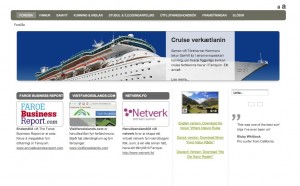 Interview with Ms. Elin Brimheim Heinesen, Managing Director of SamVit – Faroe Islands Enterprise
Interview with Ms. Elin Brimheim Heinesen, Managing Director of SamVit – Faroe Islands Enterprise
By Búi Tyril, Faroe Business Report 2008
Their outlook is increasingly global yet people in the Faroes are proud of their national identity—after all, the unique Faroese culture is alive and kicking, their islands are truly beautiful, and their fishing is the envy of the world.
Rumor has it that the man credited for introducing the term ‘nation branding’ not long ago called the Faroe Islands “the Shangri La of the 21st century.” Assuming there is verifiable substance behind the alleged statement, a first question to follow would be: In using such words about this very small country, what does an international authority on branding of places mean to imply?
According to the Economist, “Simon Anholt is one of the world’s leading advisers to governments who wish to build global brands.” Now that does lend a touch of class to whatever he has to say about the competitiveness of any place. The man behind “the first analytical ranking of the world’s nation brands”—the Anholt Nation Brands Index—has in fact developed a method of surveying tens of thousands of consumers in dozens of countries on their “perceptions of the cultural, political, commercial and human assets, investment potential and tourist appeal of each nation.”
True, as a brand, the Faroes may still have a long way to go. It takes financial muscle to run sizeable marketing campaigns. But something is on the move, says Elin Heinesen, managing director of SamVit, also known as the Faroe Islands Enterprise.
“Globalization appears to be an unstoppable megatrend that brings a lot of great things,” Ms Heinesen says. “Its influence penetrates everyday life in the Faroes as well as everywhere else; but it nonetheless poses many challenges for communities around the world. One of the major problems with modern life as experienced in big cities is the eradication of cultural differences—the lack of diversity undermines people’s sense of uniqueness and distinction. In this context, the Faroes is becoming attractive because of our special combination, somehow representing the opposite of what many city dwellers are growing weary of, and yet exciting at the same time.”
Once you’re there, the funny thing about this closely knit, self governing community in the middle of the Atlantic Ocean is first and foremost its constantly manifested, stunning contrasts that keep coming at you.
Starting with road infrastructure, the 48,000 strong island nation enjoys building roads and submarine tunnels for billions of Danish krones (hundreds of millions of euros). What kind of proportions would that translate into in your home country? You do the math.
You may try to touch upon any controversial subject in the Faroes; succeed (difficult for anyone not local) and you’ll have people going on forever over peanuts. But ask anyone for a helping hand—no, don’t even ask—and you’ll be treated to genuine generosity of the kind that will make you feel like home.
Again, expect surprise.
Now, try to push a Faroese for a decision on some relatively important issue, something that bureaucrats elsewhere would spend months on, and you’ll be amazed at the most prompt expediency you’ve ever seen. Take another angle and ask any Faroese manager what his or her time schedule will look like over the next few weeks, and the most likely answer: “Well, it depends…”
Hence the old nickname, the Land of Maybe. But again, note the contradicting combination of spontaneous swiftness and ready submission to the force majeure that be.
“The Maybe factor has been on the retreat for half a century but it’s undeniably still there,” Ms Heinesen says. “The weather still decides a lot, and the ocean is still by far our most important source of income.”
Indeed, fishing and the ocean is the very life of the Faroe Islands, yet the majority of the population is employed in private and public services. Then there’s the arts and crafts, Ms Heinesen points out.
“Our traditions in arts and crafts are held in high esteem and I believe their continuance is extremely important,” she says.
“There are strong currents driving opportunities in our direction—foreigners see something new, different and unspoiled in our culture. At the same time, we have up and coming Faroese music artists gaining audiences around the world, and the same goes for several clothing designers.So while Internet technology and universal awareness of global issues are placing these islands firmly on the world map, the Faroese are themselves keen on keeping their cultural balance intact—as well as the ecological one—and learning to capitalize on it. Otherwise, a community entirely dependent on the sustainable harvesting of its marine resources would neither survive nor prosper.




